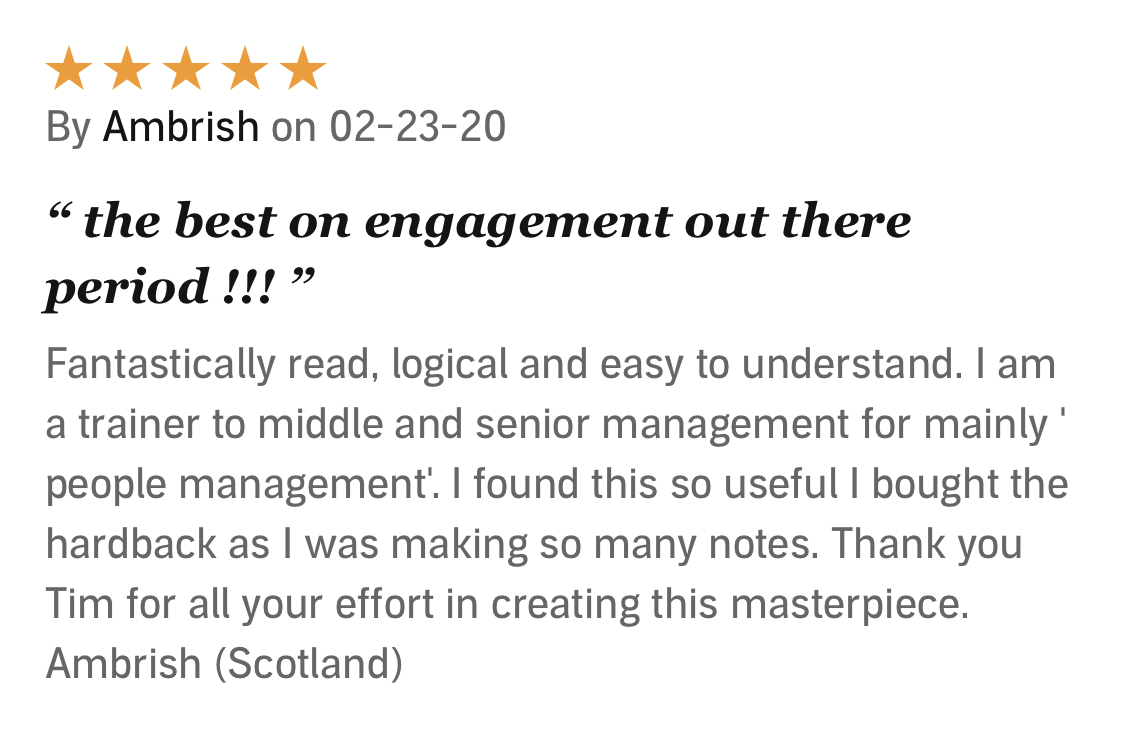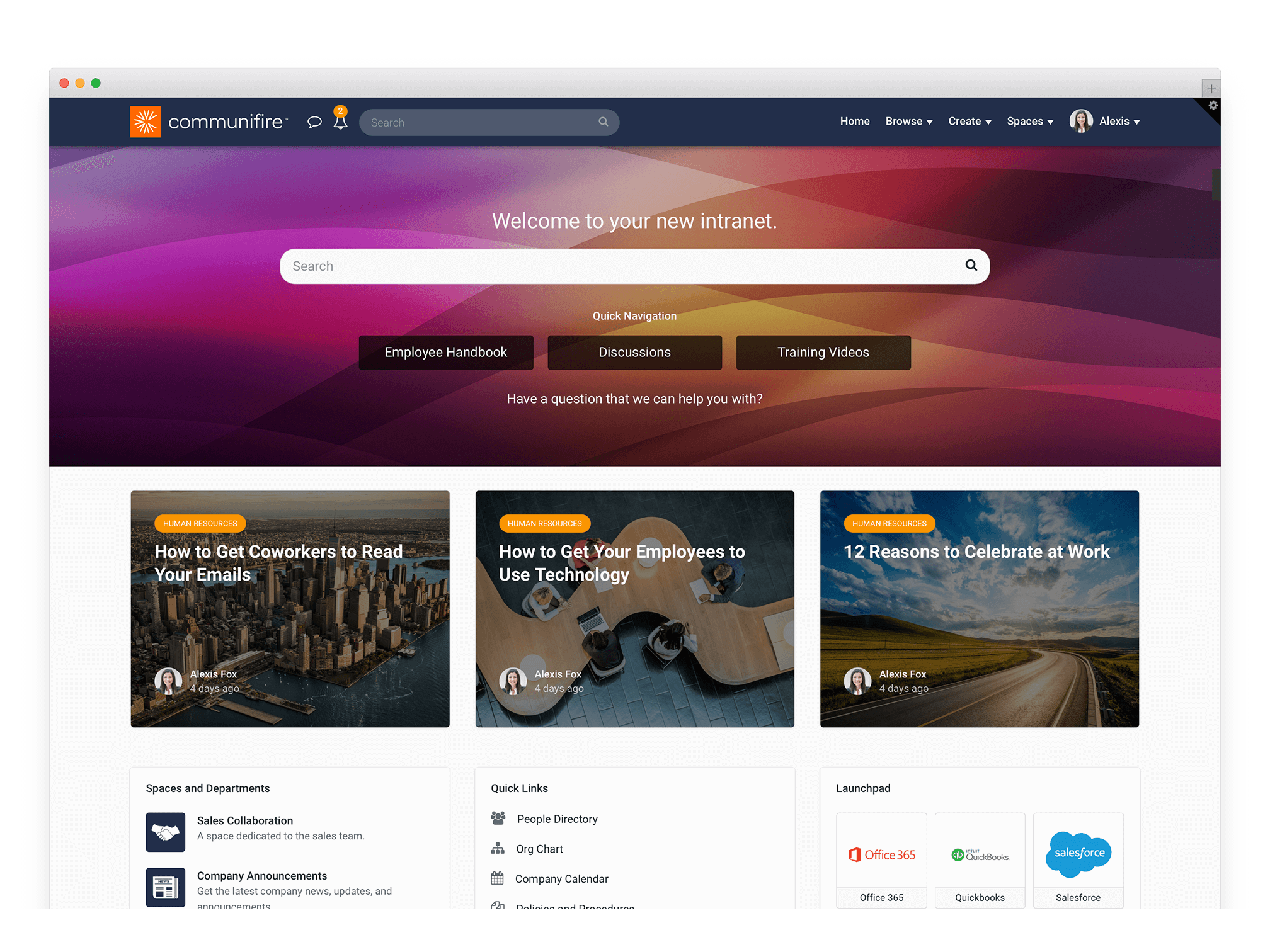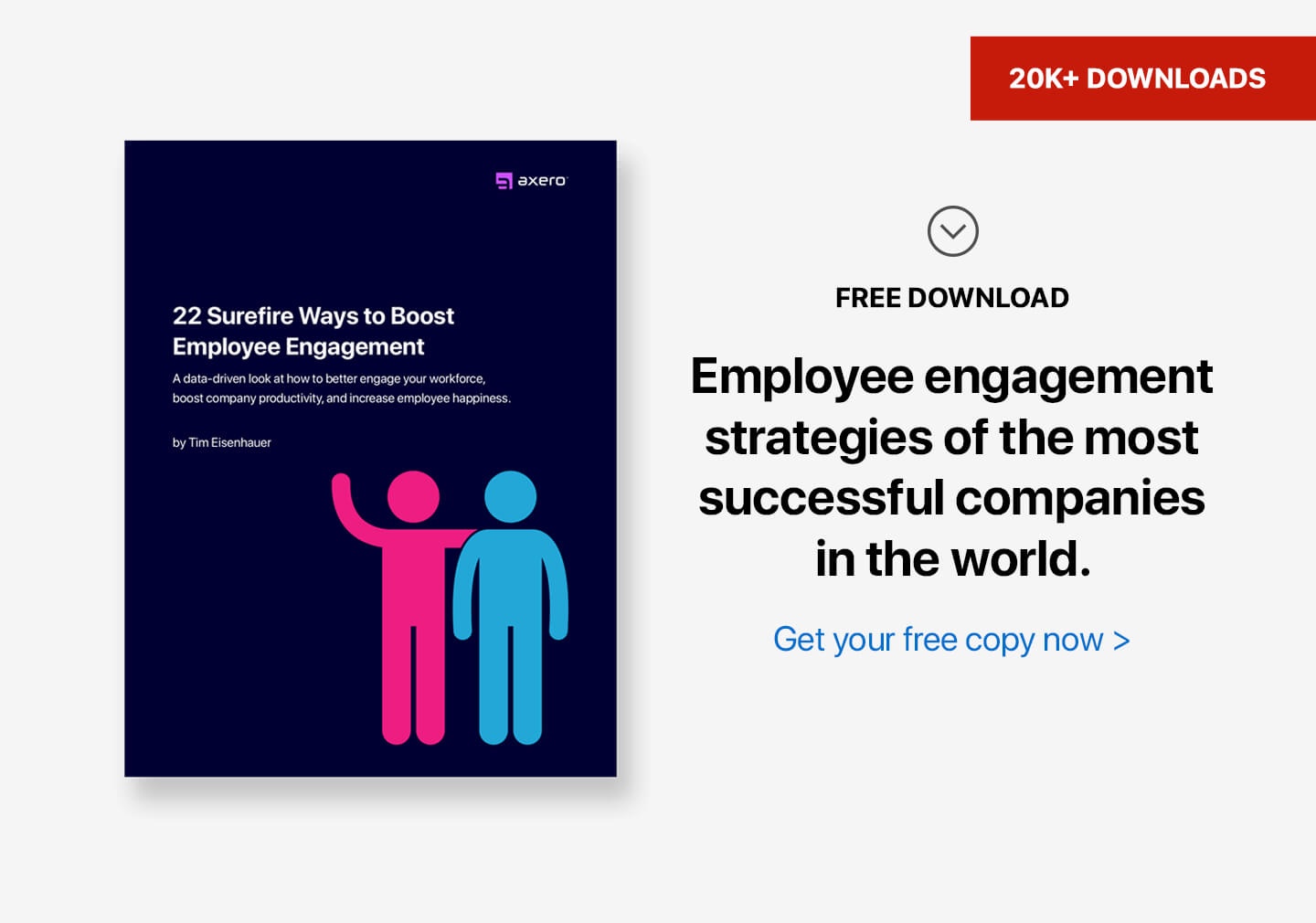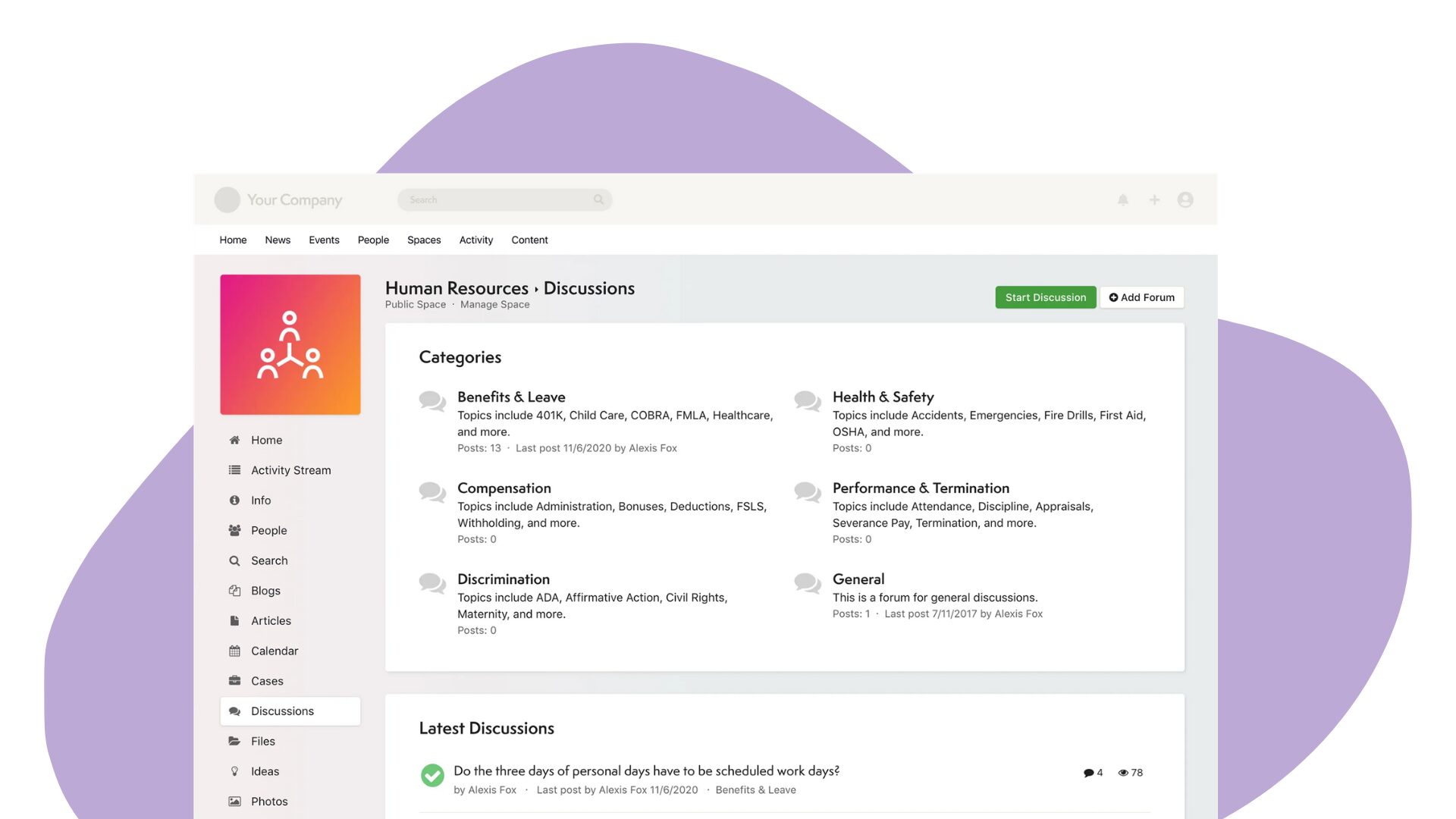Updated: February 23, 2020
Since you landed on this page, it’s quite certain you believe that your company has an employee engagement problem. You are not alone.
When I first published this post back in 2014, I had no idea how popular it would become. Since then it’s received millions of page-views. I also had no idea how many other people on the Internet would rip-off my ideas and publish competing posts using my research and information. Ouch. If you search “employee engagement ideas” on Google—and I am willing to put my neck on the line—every post that comes up is a copy of this post.
While I can’t blame people for copying, I have come to understand and accept that it’s a good thing. The more people are talking about this subject, the better off we are to do something about it.
But beware.
Employee engagement has become its own market. Indicators of the market demand are hundreds, if not thousands of blog posts, studies, surveys, and reports published by Gallup, Aon Hewitt, Blessings White, SHRM, DDI … The list is endless. To meet the growing demand for coverage, Gallup is now conducting monthly, rather than annual, employee engagement surveys. Those on the front lines who experience it every day want to be told what to do—and how to do it. They crave a solution.
Hundreds of software and consulting companies have popped up in recent years to sell tools and programs to solve the engagement problem. As always, the media loves the bad news. An army of business journalists and writers, including yours truly, have been keeping it in the spotlight. Top-tier publications have launched entire sections on their websites dedicated to employee engagement news and advice. The hunger for sanity, practical wisdom and compassion in the workplace is extraordinary.
There is no shortage of advice on the subject of employee engagement. However, much of the advice centers on masking the problem with creative strategies, not eliminating the root causes.
While a list post, like this one, can get you on the right track, it is by no means a solution to your problems. There are no quick fixes. This is only scratching the surface. You can get plenty of takeaways, however. And for those of you wondering if there are actually 499 employee engagement ideas here, I don’t know, because I lost track. What you’ll quickly learn is that it’s not about how many ideas you can come up with, it’s about how you apply them to your company, your employees, and yourself.
Oh, another thing. Due to the popularity of this post, it led me down the engagement rabbit hole. Why are so many people searching for ideas? After four years of research, I later crawled out of the hole and published a book on the topic: Who the Hell Wants to Work for You? Mastering Employee Engagement.
If you want to learn what actually works—how to improve engagement in your company—I suggest you check it out. It’s full of personal stories, case studies, and research from some of the best companies in the world. It’s available on Amazon in hardcover and audiobook. It’s a fast and entertaining read to be retained as a mental reference for daily use. (It’s also a great gift to anonymously leave on your managers desk.) And many people more important than I am have said it’s one of the best employee engagement books available.
For those of you not interested in purchasing and taking the time to immerse yourself in a book (you can probably read it in one or two sittings—I heard it’s an addicting read), have no fear. I’m giving away the outline as the new and updated first part of this article—these are sure to get your mind spinning. The second part of this article is the original post from 2014. Good luck with that and all the other list posts you’ll find on Google!
So, let’s get to it.
Here are the employee engagement ideas you’ve been looking for …
Chapter outline of Who the Hell Want to Work for You? Mastering Employee Engagement
Part 1: Empower the Individual
Introduction: Employee’s View: The Cubicle-Side Dilemma
- Disengagement happens when employees quit mentally or lose interest
- Analysts, journalists, and media keep the engagement topic alive because they make money from it
- People no longer work just to survive
- Employee disengagement is a real problem in the US and the world
- Engagement drivers: autonomy, mastery, purpose, success, community
- The problem starts when companies place too much of a burden on the employees for empowering themselves
- When we empower ourselves, we benefit ourselves
- When we empower others, we benefit the business and our cause
Principle 1: Hire Traits and Behaviors
“Hire for attitude, train for skill” (Southwest Airlines)
- Know winning traits and behaviors in your line of work
- Don’t defer to the resume—test for the qualities you seek
- Let them demonstrate their abilities rather than describe them
- Put them at ease and observe them
- Try them out on real-world assignments
- Pay new hires to quit
Principle 2: Engage from Day One
“We are lucky to have you” (Ritz-Carlton)
- Think through their first day at work and be prepared
- Do employee onboarding paperwork ahead of time
- Make introductions to people that can make a difference in their job
- Pause the video—let them talk
- Put them to work on the first day
- Treat them the way you want them to treat customers—from day one.
Principle 3: Set Goals
“Give me a stock clerk with a goal and I’ll give you a man who will make history. Give me a man with no goals and I’ll give you a stock clerk.” (J.C. Penney)
- Be clear about what you want and why
- Set goals that speak to the heart
- Set goals that take extra effort
- Test new ground with modest goals – let them prove they are ready for more
- Let them set their own goals
- Adapt your performance management tools
Principle 4: Keep the Eyes on the Prize
“I feel like when I go to work now it’s exiting and we’re in a game.” (Applebee’s)
- Make sure employees and the company are in the same game
- Use gamification to keep score
- Connect employees with those who benefit from their work (customers, partners, other employees)
Principle 5: Network
“If you want to hire and retain great young employees, you have to work the way they live.” (HubSpot)
- Blow their horn
- Communicate inclusively
- Use social media (outside)
- Build social intranet (inside)
- Introduce people horizontally and up and down the chain
- Shift vital tasks into social (Social performance management, anyone?)
Part 2 – Empower the Relationship
Introduction: Managers View: What Kind of Boss are You?
- The Manager is potentially the biggest hazard in the workplace
- Managers need to be supportive coaches and mentors
- Build relationships between managers and direct reports
- Trust works better than fear
Principle 6: Use Them or Lose Them
“To stay vigorous, a company needs to provide a stimulating and challenging environment for all these types: the dreamer, the entrepreneur, the professional manager, and the leader.” (Howard Schultz, CEO, Starbucks)
- Understand what they like about their jobs
- Just because they are good doesn’t mean you need to overload them with more work
- Give them more opportunities to do what they do best
- Use social collaboration tools to learn how they work
- Give them time to work on their own ideas
Principle 7: Support Career Development
“Engineers hate being micromanaged on the technical side, but they love being closely managed on the career side.” (Google)
- Don’t wait for the annual review
- Give real-time feedback
- Encourage breadth and depth of experience
- Set aside time to mentor your staff
- Be fearless of good people
Principle 8: Make Them Visible
“Once a quarter, any employee can come up with an idea, put together a team, and pitch the project to the executive staff.” (LinkedIn)
- Showcase your stars
- Let people learn from each other
- Build name recognition inside and outside the company
Principle 9: Let Go of Your Inner Micromanager
“I believe that managers must loosen the controls, not tighten them.” (Ed Catmull, President. Walt Disney and Pixar Animation Studios)
- Ask them if you are a micromanager
- Involve them in goal setting
- Use non-controlling language
- Encourage them to come to you with questions
- Expect to win: micromanagement is fear of failure
Principle 10: Be Authentic
“I’ve cried at work.” (Sheryl Sandberg, COO, Facebook)
- Trust them to know you as a person (But don’t be an asshole)
- Show your vulnerability, but don’t be vulnerable (Builds authority)
- Praise them for being honest and direct
- Keep your promises and don’t lie—walk the talk
Principle 11: Help
“Even employees who make the type of wages that we pay are being hit at the gas pump. We’re working very hard to schedule people from the same part of town so they can drive together.” (Costco)
- Focus on what they are struggling with
- Practice active listening, but don’t parrot every word
- Put them at ease and build their confidence
- Encourage them to find their own solutions
Principle 12: Reward Like a King
“Since 1984, $100 million has been awarded to more than 32,000 employees. Currently over 5,500 employees are receiving scholarship funds.” (Wegmans)
- Choose rewards that make a difference in their lives
- Make it clear what the reward is for and how the winners are chosen
- Create new opportunities to win
Part 3 – Empower the Culture
Introduction: Executive’s View: Gospel According to Google
- “People” are the company. Let them feel like they are the company. And let them work the way they like to work.
- The future belongs to companies that care about their employees.
- Focus on taking care of your people. The money will come.
Principle 13: Got culture?
“Move fast and break things.” (Facebook)
- A culture will form whether you like it or not.
- Start with what they really want and believe. Ask them.
- Establish a common core.
- Move with the times. React. Adapt. Reevaluate.
Principle 14: Start at the top
“We were chumps because we didn’t listen to what our sales team told us our customers were saying about the products.” (Neil Davidson and Simon Galbraith, founders of Redgate)
- Walk the talk. Do what you say you’re going to do. Back it up with action.
- Take the blame. Pass the credit.
- Own your own shit first.
- Don’t confuse cult and culture.
- Take care of others first.
- Lead by example.
- Find what moves you.
Principle 15: Communicate
“If 100% of the people hear the message 10 times, they will deliver on it.” (General Joe Robles, Jr., CEO of USAA)
- Tell them what they need to know to do their jobs well.
- Listen as you speak: start and join multi-way conversations.
- Respond in real-time.
- Influence all three streams of communication. (Company to Employees, Employees to Company, and Employees to Employees)
- Use plain and simple language.
Principle 16: Give them a Voice
“You want debate very simply because you want to make good decisions.” (Carlos Ghosn, CEO of Renault and Nissan, Chairman of AvtoVaz)
- Ask for employee feedback.
- Have a clear decision-making process.
- Take action.
- Support employee-led programs.
Principle 17: Default to Open
“We share everything, and trust Googlers to keep the information confidential.” (Google)
- Give all employees equal access to information
- Decide what, if anything, you need to hide
- Be transparent in pay and promotions
Principle 18: Go on a Mission
“Build the best product, cause no unnecessary harm, use business to inspire and implement solutions to the environmental crisis.” (Patagonia)
- Discover what drives your decisions. That’s your mission.
- Soul-search and crowd-source the right words
- Don’t try to “cover all bases”
Principle 19: Engage Outside of Work
“I do environmental compliance work, and I have a passion for recycling and reuse.” (Cummins)
- Stay on your mission when not being paid
- Check supply and demand for volunteers for your pet cause
- Choose projects that speak to them and build work skills
Principle 20: Say Thank You
“Treat employees like they make a difference – and they will.” (Jim Goodnight, Founder and CEO, SAS)
- You don’t need a special occasion to thank people.
- Thank them when they least expect it.
- Thank them for things they don’t know about. You can’t be wrong.
- Make it easy for them to thank each other.
Principle 21: Give Them a Break
“After eight years, every person gets a [one-time] six extra weeks of vacation—and you can do whatever you want. But you have to come back and tell people what you did.” (Athenahealth)
- Build time to recharge into every cycle (Daily, weekly, annual, and between projects)
- Set an example (Sleep. Eat. Meditate.)
- Take mini-breaks.
Principle 22: Let the Walls Help
“When you walk through the front door, you can see the whole office and the lake beyond.” (DPR Construction)
- Un-clutter the office space
- Let in fresh air and sunlight
- Look into “green” features (What about a place to nap?)
- Make your office more like home (How about remote work?)
Principle 23: Play
“We’re looking for well-rounded females who can deliver a great experience.” (Twin Peaks restaurants)
- Laugh in the face of negativity and stress
- Best ideas come as jokes
- Let them have a ball! (They already know how)
(Original article from 2014 starts here.)
As important as it is to work towards improving your organization’s levels of employee engagement, there’s no getting around the fact that it can be rather difficult.
But it doesn’t have to be that way.
CEOs, managers, and “higher-ups” need all the help they can get in order to ensure that their staff is on the right track, especially as businesses begin to grow.
After all, everyone wants to lead their team to success, and sometimes all it takes is a few fresh ideas to help rejuvenate your employees and increase their productivity to a large degree.
Every once in a while, it helps to have a cheat sheet on your side that can help you to steer your team in the right direction. There’s no harm in referring to the following employee engagement ideas from time to time, as they can help to bring your team together and encourage empowerment, engagement and improved performance. They’re also a great way of how to motivate employees in your organization.
Keep these ideas close by, and you’ll start seeing results in no time.
1. Encourage Employees to Speak Up
It’s common for modern-day employees go through the workweek feeling uncomfortable with the concept of speaking their minds. This discomfort can result for a number of reasons, but the most important thing to focus on is trying to break it down. When people don’t feel as if they can speak up, they may be holding back valuable ideas and solutions that could help to push your organization forward.
If you want your employees to feel comfortable speaking their minds, you have to make it clear that they can do so without fear of criticism and judgement. Promote and practice candor.
Keeping an “open-door” policy is essential, and you can help to encourage your employees further by holding roundtable discussions in which they can discuss anything that may be on their minds at the moment. The more you foster an open, safe space for communication, the more likely it is that your staff will bring great ideas to the table.
2. Help Your Employees to Get to Know Each Other Better
In larger organizations, many employees go through their days without knowing their colleagues very well, if at all. The bigger a company gets, the more of a chance there will be a disconnect. As a manager, it’s important to place focus on helping your employees to get to know each other better, and there are a number of fun ways to go about doing so.
You could play office games.
Just watch all of the seasons of “The Office” and you’ll get more take-aways than you’d get from reading every employee engagement book on the planet.
Or … !
You could just plan a happy hour at the end of the workweek …. it’s a great way to cut to the chase, and to get employees to communicate with each other on a more personal level.
There’s really nothing like taking your employees out to a bar, throwing down a few hundred bucks from the petty cash, and getting them tipsy … right? Ha. Ya know, this kind of thing happens all the time. One can learn a whole lot about another when there’s alcohol involved. Some co-workers may be into this, but there may also be many who are not. Understand this and you’ll be ok. Keep an open mind. There will be a clear separation between those who are cool with this and those who are not. 🙂 Cherish these moments.
^ SIDE NOTE: I actually had a boss that did this … he’d say, “We have a new guy starting tomorrow, so put on your drinkin pants, let’s give him the official welcome to the team.” Funny thing is … although it was a basic job, it sure was fun!
But!!!
Perhaps more importantly …
You should always be sure to allow your staff to interact throughout the day and outside of work without having to worry about whether or not they’re being watched or judged. Conversations related to business are surely important, but that doesn’t mean your staff doesn’t need a break every once in a while. To be human is human.
3. Serve as a Mentor
When an employee begins to experience problems with engagement, it’s essential to step in as quickly as possible so that things don’t progress further. Some managers simply don’t take the personal approach that is often necessary for getting through to an employee, and instead rely on canned methods and techniques that will supposedly help to raise engagement levels. Unfortunately, these individuals are taking the wrong route the vast majority of the time.
Improving your employee engagement model means serving as a mentor for those who are facing issues, regardless of how busy you may be.
Offer your help. Drop what you’re doing and just help!
Setting aside just a bit of time to help someone who is struggling in their job can go quite a long way, and you can always task other managers with taking the reigns if you truly don’t have the time to do it yourself. So long as someone is mentoring the employee in need, you can rest easy knowing that no one is being left behind.
4. Only Reward Employees for a Job Well Done
Some managers believe that one of the best way to keep employees engaged and performing well is to reward them on a regular basis, even if they’re not performing up to par. Unfortunately, carelessly dishing-out rewards won’t serve to do your business any favors and may even hurt performance and engagement even further. Instead, you’ve got to be quite careful with how you utilize rewards.
Case in point … if you reward your dog every time he sits down, rolls over, or fetches a stick he’s going to get comfortable. And when he gets comfortable, he poops on the floor.
Rewarding employees is certainly something that you should do from time to time, but that’s not to say you should do so carelessly. Pay close attention to the progress made by your employees, and don’t hesitate to let them know WHY you’re rewarding them, whether it be via a bonus, salary increase, a pat on the back, a verbal thank you, or otherwise. As long as you make a point to clarify the reason for the reward, you’ll effectively help to increase the chances that they’ll remain engaged in the future.
5. Focus on Collaboration & Working Together
Take a look at any employee whose engagement levels seem to be suffering, and you might find a constant — they’re likely to prefer to work alone.
Collaboration is one of the most important things for businesses to focus on improving, as it can help to improve ideas, cut down on wasted time and — yes — improve employee engagement. It may seem like a lofty goal if your employees tend to stick to themselves, but it doesn’t have to be at all.
One of the best ways to improve collaboration in your company is to implement online collaboration tools.
This serves as a virtual platform that all of your employees can work off of, which means they’ll have little choice but to work with one another, regardless of how shy or disconnected they may be.
It’s important to view employee engagement software not as a way to “force” employees to collaborate … but … as a tool for motivating employees to branch out and work more closely with their colleagues. Once they get the hang of how to use it, social intranet software becomes an incredibly powerful tool that will likely serve a huge role in the future of business.
6. Encourage Positive Health & Wellness
If you want to have a staff full of engaged employees, you’ve got to take steps yourself to help them remain happy and healthy.
Wellness is important for any professional, yet stress and other life factors can sometimes get in the way and cause people to neglect exercise and healthy eating habits. In the end, it stands to reason why so many businesses have issues with engagement — it’s a product of modern society.
Go have lunch with your coworkers. Have lunch with those that report to you. We’re humans, we stuff food in our face all day, and we do it socially. So get social and go stuff some food with the people you work with. There’s a lot you can learn about people, and yourself, based on how and what they eat.
Encouraging wellness within your organization doesn’t have to be hard. Some companies provide their employees with gym memberships, for example, while others choose to bring in massage therapists or other professionals to help staff members de-stress and maintain clarity. It can even be as easy as stocking healthy snacks in your company refrigerator for employees to turn to if need be throughout the day, as every little step towards wellness will serve to improve levels of engagement in your organization.
7. Clarify Goals and Responsibilities
Every employee has a set of goals and responsibilities they need to work on. One of the biggest contributing factors to falling engagement levels, is the confusion over what one’s role actually is.
It doesn’t take poor management for issues such as this to occur, either. (Though usually it is due to poor management.)
Keep in mind that sometimes, things simply get lost in the mix, and it can take time to realize what happened before you’re able to identify the issue and take action.
Clarifying goals and responsibilities is essential if you intend to improve your employee engagement strategy … a staff member simply can’t be engaged in something they don’t understand.
Whenever you kick off a project or delegate out a new task, it’s essential to go into the logistics in as detailed a way as possible, taking time to answer any questions that your employees may have. You may end up spending a little more time explaining things, but the fact that you’ll be likely to experience less headaches as a result, makes doing so more than worth your while.
8. For New Hires, Start on the First Day, Perfect the Onboarding Process
There’s nothing more depressing for a manager than hiring someone who seems as if they’ll be an excellent fit for the job, only to find that they simply aren’t nearly as engaged in their work as they should be.
Sometimes the issue stems NOT from the individual, but from the way they’re onboarded. Joining a new company can be a very stressful experience, and the more help a new employee can get, the better they’ll be at their job.
It can be tempting to allow employees to fend for themselves during the onboarding process instead of helping them through each step, but you’ll benefit greatly from being there in case they’re in need of a hand.
Onboarding doesn’t have to be a lengthy process, but it most likely will be if you don’t help to move things along.
CEOs and those in managerial positions should make themselves available when new employees join the team, as this will help to ensure any issues that pop up are negated as quickly as possible.
9. Be Flexible
The best managers are those who hold their employees accountable for their performance, yet give them the flexibility they deserve. These are professional adults, after all, and they don’t need someone breathing down their neck at all times. It can be quite difficult for those in leadership roles to give up control, especially when working on high-profile projects.
That said, it’s essential to realize just how much of a difference a little bit of flexibility can have on an employee’s performance and level of engagement.
There are plenty of ways to prove to your employees that you’re willing to give them the flexibility they need. You could allow them to work from home, for example, or take a personal day if need be. So long as they keep up their end of the deal regarding the work they’re supposed to get done, there should be little to worry about.
Note, however, that it’s important to keep an eye on how certain employees respond to extra flexibility, as some may take things too far, in which case an intervention may be warranted.
10. Help Employees Move Forward in Their Career and Education
No manager wants to admit that their employees may someday go on to work at a different company … but that’s typically the reality of things.
In today’s world, the sky’s the limit, and many people put a great deal of effort into advancing their career as far as possible through education, workshops, and other enrichment tools.
A good manager is one who is there to help their employees reach their goals, even if that means they may someday leave the company.
If you want to improve engagement levels, you need to show your employees that you’re here to help.
You can do this in a number of ways, such as paying for classes, allowing employees to attend workshops during workday hours, arranging internships, and more.
Most importantly, you should strive to be there for your employees should when they have any questions about YOUR career and how you got to be where you are at.
Sometimes, all it takes is giving out some simple advice to let someone know that you really care.
11. Create a Unique Office Environment
Showing up to an office every day can be a trying experience after a while, especially if the environment isn’t altogether comforting.
No one wants to sit in a dimly lit cubicle between the hours of nine and five … yet this is, unfortunately, the way many people live their lives.
Managers, CEOs, and the “higher ups” shouldn’t settle for such a dull work environment, as it will do nothing to help push an organization in a forward direction or improvement engagement levels.
All this said, you should strive to do whatever you can to create an office environment that is unique, comfortable and reflective of your branding.
Creating culture within your office is something that is typically done one step at a time. Artwork, music, branded mugs/dishes, even an office pet are just a few things that can help to add character to your work environment, but this barely scratches the surface of what is possible. So long as you constantly keep in mind the notion that your office should be fun and inviting, you’ll be doing what it takes to improve employee engagement levels and make the workweek just a little bit less stressful.
Having a cheat sheet by your side can help to ensure things don’t ever get out of hand, especially if you’re managing a large staff. The more of the above ideas you can incorporate into your organization, the better. Just be sure to avoid overwhelming your employees, and all will be well.
12. Hire Based Upon Traits and Attitude
Every manager wants to have employees on-staff that have a great deal of experience and have incredible qualifications on their side. After all, these things do matter, and great experience can sometimes signify a great employee. Perhaps the most important thing to remember when it comes to hiring, however, is that traits and behaviors should be focused on above all else. Everyone can get ahead if they try hard enough, but this doesn’t necessarily mean they’re going to be engaged in their work.
More often than not, you can spot the traits that might make a person a great candidate to join your team from miles away. Employees that are most likely to be engaged in their work are those who are excited, personable and not afraid to speak up. Typically, these traits will come out during the interview process; especially if you take the time to conduct a thorough interview with each and every candidate. A resume may be able to tell you what type of professional experience a potential employee has under their belt, but there’s no substitute for a face-to-face interview when it comes to getting a sense of someone’s attitude.
13. Hold Fun in High Regard
One of the most unfortunate aspects of modern office culture is that many people don’t associate the word “fun” with work.
It can seem at times as if the two are mutually exclusive, with fun being something experienced outside of work hours and the office.
The fact is, that there are a number of ways to incorporate fun into the workday, and the benefits that doing so can have on employee engagement levels within your organization are countless.
All work and no play makes Jack a dull boy.
You don’t necessarily need to disrupt your normal workweek in any way to incorporate fun into the office. Starting a company band and jamming on Fridays, holding contests within your organization, and taking a little bit of time out for some physical activity are just a few ways in which you can make the day a bit more fun for you and your employees … each of which can help to lower stress levels and serve as bonding activities for your workers.
As fun can help to break the monotony of the day, it can also help to improve employee engagement levels.
14. Let Your Employees Focus on What They Do Best
Employees want to know that the work they’re doing is being appreciated and meaningful … and if they do, they will be engaged.
They also want to be given the opportunity to shine, which means they have to have the ability to do what they do best as often as possible. The biggest mistake that a manager can make is assigning tasks to those who work under them that simply don’t match their skills … which is something that can not only lead to poor performance, but will no doubt have a negative impact on employee engagement.
If you want your employees to stay as engaged as possible, you have to allow them to focus on their skills.
First, ask them what they feel most comfortable taking on task-wise (which will help to let them know that you’re paying attention). They’ll most likely identify areas in which they have specialties that can also benefit your organization, so take this information and keep it top-of-mind when assigning tasks.
Over time, you’ll be building a team of individuals that are experts in their own right.
15. Encourage Networking
A great employee is one who is driven and focused on improving his or her own career as much as possible.
You don’t want a complacent … because even if they’re engaged in their work at the moment, this particular trait will no doubt lead to problems for your organization down the road.
Encouraging your employees to network with others (both inside and outside of your organization) is a great way to help them focus on building their careers, all the while helping them to be more engaged in their current roles.
There are so many ways to network in today’s world that it can be relatively head-spinning. Take a look at the popularity of social media and professional networks like LinkedIn, and it becomes quite clear just how much focus is placed on networking in modern society.
You can encourage your employees to utilize these services for outside networking and implement company intranet software for internal networking. Send your employees to tradeshows, conferences, workshops, educational talks … send them to events where they can learn something!
The possibilities are endless, and the more your employees focus on building their networks, the more your business will benefit in the end.
16. Create a Truly Authentic Mission Statement
The popularity of the “mission statement” in today’s business culture is difficult to ignore. It seems as if every company has their own statement to the public, some of which can be extremely well-composed and honest … to those that are being pushed out by the best marketing-manipulation-seduction teams in the world.
What often goes overlooked when creating a mission statement, is authenticity.
A simple, to-the-point phrase may have quite a bit of impact when properly presented, but this isn’t to say that it actually means something to your employees. Or anyone else.
Your employees want to know that they are part of a greater good, which is why it’s so important to ensure that the mission statement you end up drafting is one that everyone on your team can get on-board with.
Ideally, you want employees to view your company as an entity that takes action towards reaching important goals and finding solutions that will benefit the community as a whole. This is only possible when a true, proper mission statement is created, which can take quite a bit of time and brainstorming.
Getting your employees involved in the process is a great way to ensure that you’re not missing the mark.
17. Make Use of Philanthropy
The best businesses are those that place focus on giving back to the community.
Many employees will be quick to say that they’d prefer to work for a business that places some focus on philanthropy … as this not only looks good on their resume … but allows them to go home at the end of the day knowing that they’re doing a good thing.
Philanthropic organizations tend to have high levels of employee engagement.
As anyone who is experienced in philanthropy knows that there are many more ways to get involved in the community than could ever be listed in a single space.
You can donate money to help fund a local non-profit, for example, or pay for renovations of historic buildings in your area. Make a list of different angles you might wish to take, and don’t hesitate to ask your employees for feedback and ideas of their own. If as many people in the organization as possible have interest in a single form of philanthropy, engagement levels will surely rise.
18. Don’t Just Use Money as a Reward
No employee is going to turn down a raise … and there are plenty of reasons for giving one … you can throw money at any problem. Sometime people aren’t looking for money. Maybe they’re looking for something else?
This being said, there are other ways to reward your employees for a job well done than giving them money … some of which can be even more effective when it comes to improving employee engagement.
As far as rewards go, you may want to consider giving extra time-off to employees that have done well on a project, or perhaps tickets to go see their favorite band or sports team. If they go eat chinese food next door everyday, get them a gift card. Write them a handwritten thank you card, something they can hang at their desk. Ask them if there’s a book that they’ve been wanting to read, and get it for them.
This will help to clarify that you truly care about your staff, and it doesn’t have to cost you nearly as much as increasing their salaries might.
19. Give Your Employees Visibility
If there’s an employee engagement idea that practically every employee can attest to, it’s wanting to be given credit for the hard work they’ve done.
Giving your employees visibility within your company can have a huge impact on their levels of engagement … and it’s often exactly what it takes to help someone feel more in-touch with their job.
“You Matter.”
Sometimes, all it takes to give visibility to an employee is to put their name in or on something that other people will see.
If someone had a huge part in spearheading a campaign for a new product or service, give them credit in a press release or mention them in the company newsletter on your digital workplace platform. @Mention them in your Intranet (where other people can see it) and thank them for a job well done.
The more you can give them visibility, the more likely they’ll be engaged.
20. Allow Time During the Day for Personal Enrichment & Development
The workday can be long at times, and it can be difficult for some employees to get the time they need to work on personal enrichment.
Most people want to learn something! So give them time to learn it and better themselves.
The weekend is only so long, and many people are exhausted at the end of the workday. If you want to improve engagement levels, you may want to allow time throughout the day for people explore something new.
Each day, allow your employees to take a half hour or so to work on something they’re passionate about, even if it isn’t work-related. It may seem as if you’re losing time doing this, but in the end, you’ll actually be making the environment more comfortable for you employees, which will lead to a more engaged staff.
21. Celebrate Your Staff: Birthdays, Accomplishments, etc.
Most managers know they should put effort into recognizing their employees for the work they do, but that’s not to say that staff members shouldn’t be recognized simply for being a part of the team.
When employees feel like they’re getting the proper amount of attention, they typically have more of a pull to be as engaged as possible in their work.
Celebrating your staff is essential.
Pick and choose specific occasions to celebrate, with time-out from the day … these can include birthday parties, work anniversaries, the birth of a child, or major professional achievements.
Or … better yet … nearly every day of the year has designated as some type of holiday … they might be informal, weird, stupid, meaningful …etc.
You can find a bunch of these days here: http://www.holidayinsights.com/moreholidays/april.htm
Even more important, is to pay attention to random accomplishments, be they personal or professional.
22. Experiment With Employee Engagement Activities
Do a Goolge search for “employee engagement activities,” and the amount of results that pop up will most likely overwhelm you. This is because employee engagement activities really do hold a great deal of importance in today’s world, and most managers are doing everything possible to keep their staff engaged.
The best way to find employee engagement activities that work for your team is to experiment with a number of different ideas and see what sticks. Ask your staff what they like to do for fun … then experiment with those activities.
Keep your staff’s preferences in mind when choosing activities to try, and you’ll no doubt find options that will benefit your organization.
23. Put Petty Cash to Good Use
Most businesses have a petty cash fund sitting around. It can come in handy for parking and other small expenditures, but there are better ways to utilize your petty cash supply.
What many people don’t realize is that petty cash can actually come in handy in regards to improving employee engagement, and it all has to do with bettering the quality of your office; specifically, the front desk.
The next time you think of it, give your receptionist a chunk of petty cash in order to buy candy, toys, and other fun things to make the front desk just a little more inviting. A fishtank that your employees have to take turns feeding? An ant farm? Sea Monkeys? A chia pet?
We did both:


You’ll be surprised to see how much of a difference a more festive and playful reception area can have on your team’s morale, all at an exceptionally low cost.
After all, you’ve got to use that petty cash somehow!
24. Take Your Team Out for Ice Cream
On a hot, sunny day, just about everyone can attest to wanting to be outside … instead of within the confines of an office.
While there’s no getting around the fact that the work week must go on, it never hurts to go out of your way to give your staff a break from the pressure. If the heat is too much, cool them off. There’s no better solution than to take your team out for ice cream.
Who doesn’t love ice cream?
Going out for ice cream is not only an excellent way to beat the heat, but it’ll give you and your team a chance to catch up and chat about things that might not come up just hanging around the office. It’s a low-cost method of allowing your team to step away from the action and take a breather, and you can make it a regular thing during the summer if the idea resonates with your staff. It’s just one more aspect of the day that your employees can look forward to, which can have a number of positive effects on engagement levels.
25. Encourage Your Staff to Work on “Pet Projects”
One of the best ways to make an employee feel as if they’re truly important to the company they work for is to task them with taking the reigns and putting control directly in their hands.
Chances are, each and every member of your team has a unique idea or two to contribute to the overall goal of your organization, and the more you encourage them to work on a project under their own terms, the more likely it is their ideas might come to fruition.
Each week, strive to encourage your employees to spend approximately 10% of their time nurturing a “pet project” that they feel might be beneficial to your company, regardless of what it may be. In this way, your team will feel engaged in their work, stress levels will be lessened and you may end up stumbling upon an idea or solution that could push your business in an entirely new direction.
26. Let Employees Work in Other Departments on Occasion
If there’s one thing that can make employee engagement levels soar, it’s helping your staff to learn the ins-and-outs of the business entirely.
What this means, is that members of your organization need to have the chance to see what it’s like to work in a department other than their own.
After all, you can only expect to get a small part of the picture if you’re constantly stuck in your own world, and the same can be said for any other member of your company.
By allowing your staff to move around from one department to another on occasion, you’ll not only help employees to get to know each other better, but everyone will begin to see the ways in which the business truly runs. This typically leads to a more engaged workforce, and each employee will bring with them the information they take away from working in other departments to apply it to their own position. It’s truly a win-win situation, and more than worth experimenting with.
27. Hold Regular Brainstorming Sessions
Ideas are very much like water.
When things are flowing, the benefits are as clear as day, and everyone is in a good mood.
A lack of ideas is like a drought, starving your business of potentially and stifling progress.
The more you can do to foster the creation and sharing of great ideas within your organization, the better off your business will fare in the long run and the more engaged your employees will be.
The best way to keep ideas flowing is to hold regular brainstorming sessions with your staff. Promote candor and open talking. No criticism. No discussion is wrong.
Allow them to articulate ways in which they feel your organization could benefit and see progress, and don’t be close-minded about anything they may say.
Sometimes, all it takes is a seed of an idea in order to spark something magical, and you’ll be missing out on an ocean of potential if you ignore what your staff has to say.
28. Schedule Quarterly “Side-by-Sides”
It’s amazing just how fast time can go by when you and your staff are focused on the tasks at hand. Remaining mindful of time that has passed is essential to getting the most out of that which you have, and it’s important to check-in with your staff more than not.
Checking-in will not only allow you to monitor the progress of your employees, but it will also cut down on how much work it will take to fix any potential issues that might come to light.
Every few months, plan on having one of your managers do a “side-by-side” with an employee, during which they’ll follow the person through their day in order to get a better sense of their work tactics. This is also an excellent opportunity for your staff and managerial team to bond with each other, it’s a learning session for all of those involved … which can help to boost engagement levels. Plus, they’ll have a chance to ask any questions that may have recently been on their minds.
29. Let Employees Set Their Number of Yearly Sick Days
Contention in the workplace can be difficult to avoid at times, especially when it comes to holidays and sick days. Often, employees will get the sense that they aren’t receiving the amount of paid time off that they feel they deserve, and these feelings can sometimes build to result in problems related to employee engagement.
While there’s no easy way to avoid this problem, one method you could experiment with is allowing your staff to choose the amount of yearly sick days they have off.
It stands to reason why some managers might get be uncomfortable with this concept, but there are a number of benefits that come along with taking the risk.
For one, who the hell wants to be working side-by-side with someone who is blowing snot and hacking up lung chunks? Not me. If you’re sick, stay at home and get better … and if you really want to work … work from home.
When your staff is involved in the process of scheduling sick days, they won’t be able to complain about or feel slighted with the end results, hence eliminating a rather common issue that has plagued businesses of all kinds for many years.
30. Operate on a First-Name Basis
Getting to know each and every member of your staff on a personal level can be quite a challenge if you’re managing a lot of people.
I’m really bad at remembering people’s names. I can tell you what they were wearing, what they talked about, if they were confident or not … but when it comes to their name … its just tough.
This is especially true for CEOs and managers in organizations that employ a lot of people … in which case learning everyone’s name by heart can seem next to impossible. The importance of operating on a first-name basis, should never be overlooked, as doing so can come along with a number of benefits.
No one wants to be viewed as a cog in the wheel, and feelings such as this can have detrimental effects on levels of engagement. When you call an employee by his or her first name, they no longer feel as if they’re just a number.
It may take you quite a while to learn everyone’s name, but the important thing is that you try.
Even if you slip up from time to time, your staff will appreciate the fact that you’re putting in the effort to get to know them on a more personal level.
31. Hire from the Inside First
For employees that are concerned with upward movement within an organization, there’s nothing more discouraging than working for a company that tends to hire from the outside only.
Outside hires are more common than most people would like to admit, especially among businesses that are attempting to save money by hiring cheap. This won’t do you any favors, and will only serve to cause your employees to feel further disengaged in their work.
Hiring from the inside comes along with a number of benefits, specifically for as a great employee engagement idea.
For one, the candidate will already have a strong handle on the ways in which your organization operates, not to mention the fact that there will already be working relationships with colleagues set in place.
But perhaps most importantly, hiring from within will generate excitement among your entire staff, raising levels of engagement and promoting a more positive work environment — two things every great manager should be focusing on.
32. Hold an Awards Night
Anyone who is familiar with The Office (BTW I love this show, I’m from PA and grew up about an hour from Scranton) …. anyway … if you seen the show you likely remember the episodes which involved “The Dundees,” the company’s very own awards ceremony.
It may seem like a goofy idea at face value, but there’s actually quite a bit to gain from holding an awards night, and it can be a great time for you and your staff to get together and celebrate a year’s worth of achievements.
The sky’s the limit in terms of how you can plan an awards night for your organization. You can do it in the comfort of your own office … but why not rent out a space and really make it a party?
Live music, catering, and anything else you can think of (themes come to mind) … will all help to make your awards ceremony a hit, and you can pull off a party like this without spending too much money if you plan things out ahead of time.
Just be sure you’re creative with the awards categories! Again, ask you’re employees about award categories and even let them vote on who should win awards. But remember to keep it in good fun.
33. Let Your Staff Determine Their Dress Code
Suit and tie? Khakis and a polo shirt? T-shirt and jeans? Hawaiian shirt day? How about whatever they feel most comfortable wearing?
Dress code can have a big impact on attitude, and it’s been debated time and time again over which code of dress is best for maintaining a sense of professionalism while also allowing employees to feel comfortable throughout the day.
Every office needs its own sense of culture, and the ways in which people dress can have a dramatic impact on the look and feel of your work environment. If you’re open to switching things up, you might want to allow your staff to determine what their code of dress should be.
When you’re already working with a team of respected professionals, there shouldn’t really be much of a concern over what one might wear to work.
For the most part, you should be able to trust that your employees will come to work looking good, regardless of what type of style they might embrace
Allowing your staff to come up with a reasonable dress code that everyone can be happy with is an excellent way to boost engagement levels.
34. Bring in Motivational Speakers Every Month / 3 Months
If you’ve ever seen a good motivational speaker work their magic, chances are you already know just how effective they can be at helping to improve employee engagement / inspiration / motivation / whatever. I absolutely love going to hear smart people talk, no matter what they are talking about.
(Here’s a bunch of TED talks I recently blogged about. Use them for inspiration.)
Motivational speakers help to remind your employees just how vital a role they serve within their organization, and their positivity can often be exactly what the doctor ordered in terms of improving levels of engagement.
Not just any motivational speaker will do, however; it has to be the right fit.
Plan to have a different motivational speaker come in each month, and structure the visits in a way that will benefit your employees the most. In choosing an individual to come in and speak, it’s essential that you take the interests and culture of your staff into consideration. Do your homework. Ask for references. If your employees are into music, consider bringing in a professional musician as a speaker; sports fans will respond well to local athletes. The possibilities for tailoring your motivational speaker program to best fit your organization are many, and the more focused you can get, the better.
35. Have a Potluck Lunch on Thursday, or Friday
Throughout any busy work week, it’s common for employees to want to branch out and do their own thing for lunch.
While there’s nothing wrong with people getting a little solo time in during the afternoon, communal lunches can be a lot of fun, not to mention beneficial to employee engagement.
Holding a potluck lunch on Thursday (near the end of the work week) is a great way to get the team together and also helps everyone to save a bit of money in comparison to going out for lunch.
Potlucks only work when they’re structured and planned, so if you’re just now introducing this idea to your staff, be sure that everyone is well-aware of when and where the lunch will take place, as well as what everyone needs to bring.
The planning process is half the fun, as it allows staff members to come up with unique ways in which they can contribute to the party.
See how things go, and if it’s a good fit, you might want to have Thursday potlucks become a regular event.
36. Bring Your Employees Into the Hiring Process
Want to make your employees really feel like they’re an important part of your organization? There’s no better way to do so than to bring them right into the hiring process.
Having a staff member sit-in on an interview that you’re conducting comes along with a number of benefits.
For one, it makes them feel more engaged and appreciated. In addition, your employees’ input can be very helpful in ultimately leading you to make the right decision regarding a new hire, especially if they’ve been a part of the company for a long period of time.
As any interview process is typically awkward, it’s important that you let whoever sits in know that you’ll be doing the bulk of the actual interviewing. Just let them sit there and listen. Then when its over, ask them their thoughts on the candidate.
It’s fine for a staff member to ask a question or two, but too much can be overwhelming for the applicant. More important is asking your employee what they thought of the potential new hire after the interview is over, which is a great way to get a more well-rounded sense of whether or not the person might be a good fit.
37. Make Up Your Own Holiday and Throw a Party
Happy Logical Axiom Day!!
There’s never a bad excuse for throwing a party, so why not make one up?
If you’ve ever heard of the concept of “Christmas in July,” or “Halloween in April,” or an “80’s party” … you get the idea.
This serves as a great platform for throwing a fun party that will help people to separate themselves from the workday and have a great time with their colleagues, and it’s quite clear just how positive an effect this can have on levels of employee engagement within your organization.
The “Christmas in July” concept is a fun place to start when planning a themed “holiday” party, but there’s no reason why you can’t come up with your very own ideas for made-up holidays.
Try to align whatever you choose with the interests of your staff, and don’t forget to put a fair amount of effort into the planning process. Hell, throw some of that petty cash on the table.
After all, if you’re going to take the time to make up a fake holiday, you really need to nail down the details if you want the party to go well.
38. Take Your Staff to a Local Sporting Event
Just about every city or town has a number of local sports teams that play regularly, and tickets are usually inexpensive at the minor level.
One great way to improve levels of employee engagement at your company is to take everyone out to a local game once a month, or even buy a season pass for your company.
Many minor league teams will work with you in regards to pricing, and it’s difficult to beat the employee experience of taking the entire office out for a game. And if you contact the sports team ahead of time, maybe you’ll even get to meet some of the players. Take photos!
People can be finicky regarding which sports they’re interested in, so before setting out to make any major purchases (tickets or passes), be sure to at least ask everyone in detail about the team/sport they’d most like to go see.
It’s not always possible to make everyone happy, but you can at least come to find some common ground if you’re up-front and take everyone’s requests into consideration.
39. Allow Employees to Dictate Their Own Schedules
Scheduling can be a difficult part of the job for any manager. Or, it could be a nobrainer. You’re working M-F, 5 to 9 baby!
But the days where every team member can easily commit to a Monday through Friday, nine-to-five position are quickly fading away.
People are placing more focus on working remotely than ever before, and CEOs/managers are doing everything they can to accommodate the shift without losing too much control. It can be tricky to find the right amount of balance, but it’s more than worth working towards.
Instead of sticking to a rigid schedule that works for you but not everyone else in your company, allow your employees to dictate their own schedules. They should, of course, still end up putting in the same amount of time each week, but if you have the luxury of being able to remain flexible, how they structure those hours should be up to them. An employee who feels as if he is respected enough to make up his own mind about when to come into work will almost always remain fully engaged, as this creates a sense of trust that is difficult to come upon otherwise.
40. Get Creative with Engagement Prompts
The quickest way to gauge levels of employee engagement may be to simply give-out a survey to each and every individual in your office, but that’s not to say it’s the most effective. You can read more about surveys in my other blog post, Employee Engagement Survey Questions. Good or Bad?
One way that you can get a lot of mileage is to come up with a number of different prompts and exercises that you can utilize to gain a better understanding of how an employee feels about the organization they’re working for. The more creative you can be, the better.
A favorite way to get a sense of an employee’s level of engagement is to hand them a crayon and ask them to “draw the company” in their own unique way.
It’s not as simple as tracing the physical outlines of your office, but rather a way for employees to share the feelings they get when coming to work every day in an artistic manner. You might get a few blank stares with this one, but it’s a great exercise that can be especially helpful for onboarding new hires.
41. Have Occasional Photo or Video Contests
The days when you needed a thousand-dollar camera setup to produce even halfway decent photos are long gone.
With today’s technology, anyone with a smartphone and a good eye can capture something worthwhile. One way that you can help to further improve employee engagement within your organization is to hold an occasional photo or video contest, which can be a lot of fun even for those who have never experimented with a visual medium for creativity in the past.
You can structure your contests in a number of different ways. It could be a “just for fun” situation, or you could actually hold a contest in which the photos/videos your employees make end up on your blog, or even as a part of your branding going forward.
This is a fun way to get your staff to be more engaged in what’s happening around them, and it’s a very inexpensive tool for doing so.
42. Encourage Your Staff to Write-Up Their Own Employee Recognition Cards
A common misconception among managers is that employee’s only need to be recognized by higher-ups in order to feel engaged.
There’s no substitute for peer respect or peer recognition, which is why it’s important for you to urge your employees to give each other a pat on the back every once in a while. This makes teams work more fluidly together and can add a genuine air of respect to the office that might not exist otherwise.
Employee recognition cards are an easy solution for helping to spread congratulations around the office, whether they be physical or virtual in nature. Encourage your staff to pay attention to the achievements their colleagues make and prepare one of these cards to celebrate a job well-done.
Anyone can give anyone else a “recognition card” for a job well done.
In this situation, everyone wins, and there’s no reason for any bad attitudes to get in the way of moving in a forward direction.
43. Bring in a Band or Singer-Songwriter on Friday Afternoons
Music is one of the few universal things that can truly bring everyone together, and there’s no getting around the positive effects it can have in terms of helping people to destress. If you really want to turn Friday afternoon into a party, you should consider bringing in a singer songwriter.
I’m thinking a guy or gal that can rock the acoustic guitar … like this guy …
Having a band play while you and your team relax and celebrate the achievements of the week can be highly beneficial, and it’s not nearly as different to make happen as you might think.
The one thing to ensure that you’re paying attention to when picking a band to play during the afternoon is respecting the tastes of your employees. You don’t want to bring in a band or songwriter just because they appeal to you — this is about your team. Try to find groups that everyone can enjoy, and don’t hesitate to set up a proper stage if you’ve got the space and time to do so!
44. Sponsor a Charitable Event
Want to improve engagement levels and appeal to the general public at the same time?
Sponsoring a charitable event is one of the best routes you can take if this is what you’re aiming for.
Who doesn’t want to do some good in this world?? … and the more often you get involved in volunteer work or charity, the stronger your employees will be able to identify with what they do and who they work for.
Sponsoring a charity event can serve as an excellent move, especially if things are planned-out well in advance. For best results, it may be worth your while to work with an event planner to ensure that everything goes off without a hitch. After all, you’ll want to ensure that your event is a huge hit with both your employees and the public. This is one area where it may be worth your while to spend a little bit of money, as the benefits can far outweigh the costs.
45. Give Your Employees a Chance to Help Design Your Corporate Identity Package
A business’s corporate identity package is its bread and butter. It’s what conveys a sense of who you are to both your staff and your clients/customers, and there’s no getting around how important it is to put the right amount of work into creating a mind-blowing suite that includes letterhead, web content and every other type of associated collateral.
Sometimes, the best design ideas come not from a high-dollar outside firm but from your very own employees, some of whom you may not even know are interested in the world of design.
It can’t really hurt to crowdsource ideas.
The next time you set out to reinvent your corporate identity package, hold a roundtable discussion and invite your whole staff to attend. What you end up with at the end of the day could be as simple as a list of concepts or ideas, but it could also be as robust and detailed as a collection of design comps. Your creative team should, of course, be the ones who are leading the discussion, but it’s important to open things up to your whole staff in terms of sourcing ideas for shapes, colors, fonts and everything in between.
46. Let Your Employees Make Inexpensive Executive Decisions
In attempting to figure out why an employee is showing signs of disengagement, it often comes down to them not feeling as if they ever get the chance to make important decisions. You can’t always give up control when it comes to making decisions that could change the path of your organization, but there are certain scenarios where doing so might actually be to your benefit.
If there is a necessary decision looming and you have a staff member who has been working closely with you on a given project, you may want to allow them to have the final say in what happens. The benefits this can have on engagement levels can be astronomical, and there’s a very good chance that the decision could lead your business in a forward direction.
Note that this route should only be taken if the decision won’t potentially end up being costly — anything under $500 should be considered safe.
47. Get Rid of Set Holidays and Add Them into Vacation Time
Everyone wants to have as much control over their work schedule as they can, and this is sometimes easier said than done when they have to deal with a calendar that includes set paid days off.
Holidays can be something to look forward to, but there are other ways to structure the year that may actually benefit both you and your employees more fully, and one of the most effective is to get rid of set holidays altogether.
When you get rid of set holidays, you can effectively add that time to your staff’s vacation time, allowing them to completely structure how they’d like to make the best usage of their time off.
Seeing how this can be somewhat of a radical shift, you’d have to work out the legal issues (I’m sure there are some), and you’ll want to ensure that everyone knows exactly how the new system for taking time off works, stressing that it’s actually to the benefit of everyone in the organization.
48. Schedule a Monthly Art Class
Visual art is the kind of thing that everyone can gain something from, even if they don’t consider themselves to be an artist. Most of the time, those who don’t identify as having talent in visual art simply need a little push in the right direction, and a little bit of coaching is never a bad idea. If you want to foster a more artistic, engaged staff, then you may want to schedule a monthly art class.
Each month, set aside a workday in which either the whole or part of the afternoon will be devoted to bringing in a private instructor that can teach your staff how to paint, draw, or embrace another visual medium for creativity. You can focus on a new medium each month, for example, which is a great, low-stress way to encourage creativity without losing any aspects of fun in the process. Just be sure you choose the right instructor, and don’t hesitate to shop around to find someone who can accommodate your budget.
49. Hold a “Birthday Breakfast” With the CEO
There’s nothing more important for an employee than knowing that the CEO actually cares.
In larger organizations, however, it’s common for people to lose sight of this, which often leads to dissention and a lack of engagement. Keeping CEOs and their employees connected whenever possible is essential to improving levels of engagement within your organization.
Each month, hold a “birthday breakfast” with the CEO and everyone who shares a birthday in that month. This is a great way for CEOs and their employees to get to know each other on a more personal basis, but it also gives people the opportunity to ask questions should there be something they’ve wanted to bring up for a while. The transparency that comes along with an informal breakfast or luncheon simply can’t be beat.
Now it’s your turn!
What kind of employee engagement ideas do you have? Let me know in the comments section below. Thanks!



































